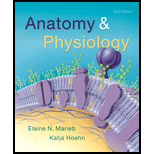
Concept explainers
Use the key to classify each of the following described tissue types into one of the four major tissue categories.
Key: (a) connective tissue (c) muscle
(b) epithelium (d) nervous tissue
_____(1) Tissue type composed largely of nonliving extracellular matrix; important in protection and support
_____(2) The tissue immediately responsible for body movement
_____(3) The tissue that enables us to be aware of the external environment and to react to it
_____(4) The tissue that lines body cavities and covers surfaces
To review:
The classification of four major type of tissues on the basis of their specific characters, into different categories.
Solution:
The classification of tissue types into major categories of the tissue:
| Tissue type | Category |
| (1) Tissue type is composed largely of a nonliving extracellular matrix; important in protection as well as support. | (a) Connective Tissue |
| (2) The tissue immediately responsible for the body movement. | (c) Muscles |
| (3) The tissue enables us to be aware of the external environment as well as to react to it. | (d) Nervous tissue |
| (4.) The tissue that lines the body cavity and covers surfaces. | (b) Epithelium |
Explanation of Solution
The connective tissues are important in providing protection and support to the body. They are composed largely of the nonliving extracellular matrix.
The body movements occur due to the relaxation or contraction of the muscle fibers in the human body.
The nervous tissues are the tissues that are mainly responsible for receiving the stimulus from various sources and react according to them. Hence, they make the body of the individual aware of the external environment.
The epithelial cells are the cells that line up the body cavities and form the outer covering.
Thus it is concluded that connective tissue, muscles, nervous tissue and epithelium are four major categories of tissues that plays specific and vital role in the body as explained above.
Want to see more full solutions like this?
Chapter 4 Solutions
Anatomy & Physiology (6th Edition)
Additional Science Textbook Solutions
Human Anatomy & Physiology (2nd Edition)
Campbell Essential Biology (7th Edition)
Applications and Investigations in Earth Science (9th Edition)
Microbiology: An Introduction
Chemistry & Chemical Reactivity
Biology: Life on Earth (11th Edition)
- Molecular Biology Question A gene that codes for a protein was removed from a eukaryotic cell and inserted into a prokaryotic cell. Although the gene was successfully transcribed and translated, it produced a different protein than it produced in the eukaryotic cell. What is the most likely explanation?arrow_forwardMolecular Biology LIST three characteristics of origins of replicationarrow_forwardMolecular Biology Question Please help. Thank you For E coli DNA polymerase III, give the structure and function of the b-clamp sub-complex. Describe how the structure of this sub-complex is important for it’s function.arrow_forward
- Molecular Biology LIST three characteristics of DNA Polymerasesarrow_forwardMolecular Biology RNA polymerase core enzyme structure contains what subunits? To form holo enzyme, sigma factor is added to core. What is the name of the structure formed? Give the detailed structure of sigma factor and the function of eachdomain. Please help. Thank youarrow_forwardMolecular Biology You have a single bacterial cell whose DNA is labelled with radioactiveC14. After 5 rounds of cell division, how may cells will contain radioactive DNA? Please help. Thank youarrow_forward
- 1. Explain the structure and properties of atoms and chemical bonds (especially how they relate to DNA and proteins). Also add some pictures.arrow_forward1. In the Sentinel Cell DNA integrity is preserved through nanoscopic helicase-coordinated repair, while lipids in the membrane are fortified to resist environmental mutagens. also provide pictures for this question.arrow_forwardExplain the structure and properties of atoms and chemical bonds (especially how they relate to DNA and proteins). Also add some pictures.arrow_forward
- In the Sentinel Cell DNA integrity is preserved through nanoscopic helicase-coordinated repair, while lipids in the membrane are fortified to resist environmental mutagens. also provide pictures for this question.arrow_forward1. Explain how genetic information is stored, copied, transferred, and expressed. Also add some pictures for this question.arrow_forward!. Describe biological macromolecules (DNA, RNA, proteins, lipids, etc.) and how they function in the cell. also provide some images for this question.arrow_forward
 Human Physiology: From Cells to Systems (MindTap ...BiologyISBN:9781285866932Author:Lauralee SherwoodPublisher:Cengage Learning
Human Physiology: From Cells to Systems (MindTap ...BiologyISBN:9781285866932Author:Lauralee SherwoodPublisher:Cengage Learning Biology (MindTap Course List)BiologyISBN:9781337392938Author:Eldra Solomon, Charles Martin, Diana W. Martin, Linda R. BergPublisher:Cengage Learning
Biology (MindTap Course List)BiologyISBN:9781337392938Author:Eldra Solomon, Charles Martin, Diana W. Martin, Linda R. BergPublisher:Cengage Learning Human Biology (MindTap Course List)BiologyISBN:9781305112100Author:Cecie Starr, Beverly McMillanPublisher:Cengage Learning
Human Biology (MindTap Course List)BiologyISBN:9781305112100Author:Cecie Starr, Beverly McMillanPublisher:Cengage Learning
 Biology: The Unity and Diversity of Life (MindTap...BiologyISBN:9781305073951Author:Cecie Starr, Ralph Taggart, Christine Evers, Lisa StarrPublisher:Cengage Learning
Biology: The Unity and Diversity of Life (MindTap...BiologyISBN:9781305073951Author:Cecie Starr, Ralph Taggart, Christine Evers, Lisa StarrPublisher:Cengage Learning Anatomy & PhysiologyBiologyISBN:9781938168130Author:Kelly A. Young, James A. Wise, Peter DeSaix, Dean H. Kruse, Brandon Poe, Eddie Johnson, Jody E. Johnson, Oksana Korol, J. Gordon Betts, Mark WomblePublisher:OpenStax College
Anatomy & PhysiologyBiologyISBN:9781938168130Author:Kelly A. Young, James A. Wise, Peter DeSaix, Dean H. Kruse, Brandon Poe, Eddie Johnson, Jody E. Johnson, Oksana Korol, J. Gordon Betts, Mark WomblePublisher:OpenStax College





